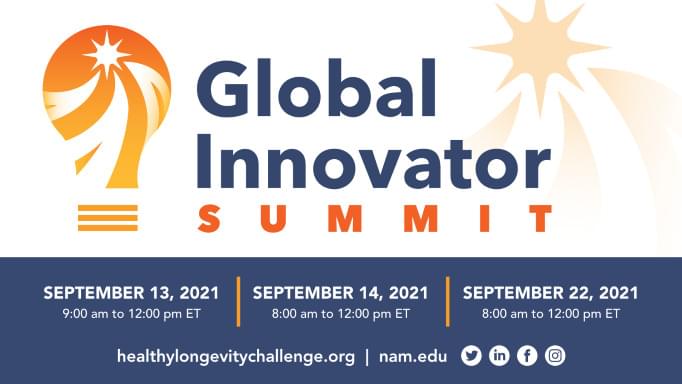The billionaires’ race to reconfigure death is the latest manifestation of a timeless human fascination.


By Harold Katcher.
The book The Illusion of Knowledge, by Harold Katcher, was launched on September 4th 2021 at Book Passage Ferry Building, San Francisco/CA. The book was published by NTZ, a publisher specialized on the rejuvenation field.
The book can be cound on Amazon:
NTZ’s website: https://www.ntzplural.com.
#rejuvenation #aging #science #health #biology #HaroldKatcher #E5 #books #antiaging
Longer, Healthier, And More Productive Lives — Dr. Jean Accius Ph.D., Senior Vice President, AARP
Dr. Jean C. Accius, PhD, is Senior Vice President, AARP Global Thought Leadership (https://www.aarp.org/). Dr. Accius leads a team in positioning AARP (formerly known as the American Association of Retired Persons) as a global thought leader, identifying emerging trends around the world, cultivating and elevating new ideas, forging global strategic alliances that become the foundation for collaboration and sparking bold solutions to change systems and improve the lives of the global population as it ages.
Dr. Accius is a passionate champion and catalyst for changing how the world sees and values aging. He is an internationally recognized thought leader on aging, longevity, equity, health systems transformation and modernizing the delivery and financing of long-term care. With tri-sector experience and deep knowledge, he has a strong track record of building high-performing teams, managing cross-functional operations and processes, and developing innovative and actionable solutions, policies, and programs to close the opportunity gap so that everyone can live longer, healthier and more productive lives.
A highly sought after author and speaker, Dr. Accius has been quoted by or appeared in numerous media outlets, including The New York Times, Forbes, TIME Magazine, USA Today, Reuters, Politico, Next Avenue, ESPN’s Undefeated, Rolling Out, NationSwell, Congressional Quarterly, and Huffington Post. In 2,020 he facilitated several sessions at the 50th annual World Economic Forum in Davos, Switzerland and also engaged nearly 300 leaders across industries and sectors, including 20 ambassadors and many delegates, at the United Nations.
Dr. Accius is a member of the National Association of Corporate Directors and has held a variety of board and advisory positions including Justice in Aging, the American Society on Aging, Leadership Maryland and the American University School of Public Affairs Board of Advisors.

While is seems like the majority of the longevity space is currently overly captivated by the Aubrey de Grey/SENS debacle, the U.S. National Academy of Sciences, Healthy Longevity Global Innovator Summit is now beginning — Most interestingly, former R&D Head at PepsiCo, Dr. Mehmoud Khan, will be speaking in his new role as CEO of the Hevolution Foundation; a potential multi-billion $$$ initiative with a longevity angle — Everyone should keep their eye on this one…
The National Academy of Medicine (NAM) will hold its inaugural Healthy Longevity Global Innovator Summit in September 2,021 with support from Johnson and Johnson Innovation and The John A. Hartford Foundation. The event will be virtual and held over three days, September 13 14, and 22 and feature an immersive, interactive digital venue with unique opportunities to engage and connect.
The Innovator Summit will honor the 154 international Healthy Longevity Catalyst Awardees from 2020 and bring together industry leaders, academics, researchers, scientists, and entrepreneurs whose work contributes to the field of healthy longevity. Attendees will learn about the early-stage, award-winning innovations, hear from leaders in the field of healthy longevity, and take advantage of various opportunities to interact directly with other attendees, with a view to fostering interdisciplinary and cross-sector collaboration.
The event will feature remarks from the President of the National Academy of Medicine, Dr. Victor Dzau, and Catalyst Award Sponsors, Dr. William Hait, Global Head of Johnson & Johnson External Innovation, and Dr. Terry Fulmer, President of the John A. Hartford Foundation. Visionary keynote speakers will share insights into launching biotechnology start-ups and opportunities for groundbreaking science in the field of longevity. Participants will also be able to enjoy a robust selection of breakout sessions and the chance to network with Catalyst Award winners, researchers, venture capitalists, and more in one-on-one and small group settings.

As we age, our bones become thinner, we suffer fractures more often, and bone-diseases such as osteoporosis are more likely to occur. One responsible mechanism involves the impaired function of the bone-marrow stem cells, which are required for the maintenance of bone integrity. Researchers from the Max Planck Institute for Biology of Ageing and CECAD Cluster of Excellence for Ageing Research at the University of Cologne have now shown that the reduced stem cell function upon aging is due to changes in their epigenome. They were able to reverse these changes in isolated stem cells by adding acetate. This fountain of youth for the epigenome could become important for the treatment of diseases such as osteoporosis.
Aging Researchers have been looking at epigenetics as a cause of aging processes for some time. Epigenetics looks at changes in genetic information and chromosomes that do not alter the sequence of the genes themselves, but do affect their activity. One possibility is changes in proteins called histones, which package the DNA in our cells and thus control access to DNA. The Cologne research group of Peter Tessarz has now studied the epigenome of mesenchymal stem cells. These stem cells are found in bone marrow and can give rise to different types of cells such as cartilage, bone and fat cells.

With all that said, it’s natural for humans to crave and eat limited amounts of sugar. After going through all the research, here’s what I am doing for myself.
For example, foods high in fructose stimulate ghrelin while suppressing leptin—hormones responsible for hunger and satiety. Sugar can promote chronic hyperglycemia, which can both lead to weight gain and is another risk for diabetes. And sugary drinks, especially, are tied directly to obesity.
Sugar and aging: a bad combination (so what should we do?)
People looking to stay young for a long time should limit their sugar consumption. While how added sugar works in the body isn’t simple or predictable, there are literally thousands of studies tying added sugar to diseases of aging.
X-Prize board member Sergey Young on his new book, and the potential for a longevity X-Prize.
“We have created science and technology to extend our life, but we haven’t created life we want to extend.”–Sergey Young, Seeking Delphi™ episode #55, explaining why he believes more people do not support radical life extension.

One of the many areas graphene promises to have transformative effects is in fortifying construction materials like concrete and asphalt. A first-of-a-kind trial now underway seeks to apply the wonder material’s impressive attributes to one of the UK’s major thoroughfares, by deploying it in a road resurfacing project along a stretch of the A1 motorway.
Made up of a single sheet of carbon atoms arranged in a honeycomb pattern, graphene offers incredible strength and flexibility, and by incorporating it into materials like asphalt scientists hope to develop road surfaces that last far longer, and therefore cost less to maintain.
Back in 2017 we looked at an interesting take on this from a pair of Italian companies that developed an asphalt material doped with a graphene additive to make it less likely to soften in the heat and crack in the cold under high loads. This product, known as Gipave, also incorporates plastic pellets and was recently rolled out along stretches of UK roads as part of trials to see how it can extend the lifespan of the surface.

In humans, as well as all vertebrate animals, turning a fertilized egg into an embryo with a little beating heart requires that stem cells differentiate, specialize, and generate specific tissues, such as bones, blood vessels and a nervous system. This process is kickstarted and regulated by retinal. Animals can’t produce their own retinal, though, they must ingest it from plants, or from animals that eat plants.
Plant roots and animal embryos rely on the same chemical for successful development.
What do frog eggs have in common with anti-aging creams? Their success depends on a group of chemical compounds called retinoids, which are capable of generating and re-generating tissues.
A new study in plants shows that retinoids’ tissue-generating capacities are also responsible for the appropriate development of roots.
Check out our second promo for #transvision #future Summit 2021 (#madrid Oct. 8 — 12), featuring the optional dinner/cocktails we are scheduling, and 2 full-day #tours of several #unescoworldheritage sites and historical places near Madrid: Segovia, Ávila, Monsaterio de El Escorial & Valley of the Fallen on Oct. 11 and Alcalá de Henares, Aranjuez & Toledo on Oct. 12. It’s going to be espectacular! You don’t wanna miss those, so get your tickets now! 😊 Get your tickets here -> www.TransVisionMadrid.com.
The event itself will be a lot of fun, so make sure to register to come to Madrid in person, or to watch it via streaming (at a reduced price). There will be talks about #longevity #artificialintelligence #cryonics and much much more.
Promo by Sergio Tarrero for Alianza Futurista as Diamond Sponsor of TransVision Future Summit 2021. Alianza Futurista will also provide live video production, streaming and post production services for this event.
Humanity Plus Humanity Plus Magazine Ilustre Colegio Oficial de Médicos de Madrid (ICOMEM) Alcor Life Extension Foundation Cryonics Institute Cryonics Institute Posthuman Network Posthuman Network Cryonics4U Longevity Conferences Longevity for All International Longevity Alliance U.S. Transhumanist Party Transhumanist Party Australia Transhumanist Party Australia Group Transhumanist UK Rational Transhumanism Singularity University Ray Kurzweil Ray Kurzweil Singularity Ray Kurzweil Singularity Ray Kurzweil’s Singularity Singularity Hub Singularity Network Transhumanismo Brasil SingularityNET Singularitarianism Foresight Institute Lifeboat Foundation Machine Intelligence Research Institute KrioRus The Hedonistic Imperative — Paradise Engineering Future of Life Institute Future of Humanity Institute (Oxford University) The Long Now Foundation Global Catastrophic Risk Institute CLUB DE SEGUIDORES DE JOSÉ LUIS CORDEIRO (OFICIAL) Aubrey de Grey Dr. Aubrey de Grey HashtagTeam 🤩